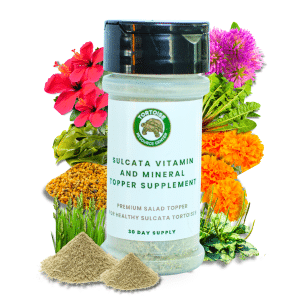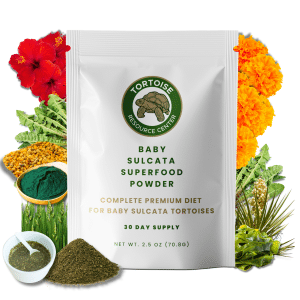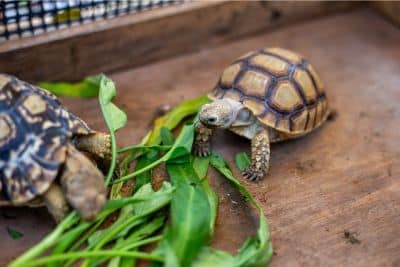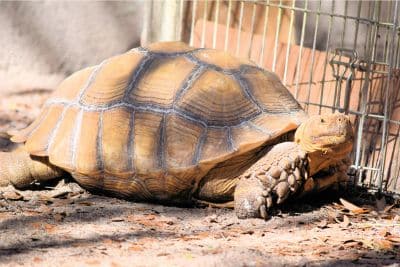From front-opening enclosures to custom-built habitats to aquaria, there are tons of different tortoise enclosures available to modern keepers. But having so many choices available isn’t always a good thing. It can actually leave your head spinning, as you try to figure out which type of enclosure will work best for your pet and situation.
One specific type of enclosure – the tortoise table – has become incredibly popular over the last several years. In fact, many keepers simply default to a tortoise table these days, without asking themselves an important question: Are they the best option available or are other types of enclosures preferable?
Unfortunately, there is no simple answer; different situations call for different solutions. So, you’ll ultimately have to simply learn as much as you can about options available to you and make the best decision you can on your pet’s behalf.
In this article, I’m here to help! I’ll be comparing tortoise tables with other types of tortoise habitats and outlining some of the things you’ll want to consider when making your choice.
What Is a Tortoise Table?
The term “tortoise table” is a bit of a catch-all term for commercially manufactured tortoise habitats that typically share a number of common features.
- They’re usually built from wood.
- They often provide your pet with multiple “rooms.”
- They usually have a wire top for safety.
- Indoor versions often have built-in light fixtures or supports from which lights can be hung.
- Some have viewing windows on the sides.
- Some have storage shelves or cabinets.
Nevertheless, these features aren’t always present. For example, some tortoise tables are simply open boxes without tops, viewing windows, room dividers, or light fixtures.
It is important to point out that while they’re often called tortoise tables, many lack legs at all and are designed to sit on the floor.
What Other Kinds of Enclosures Are Available?
While popular, tortoise tables aren’t the only option available to tortoise keepers. There are actually a variety of different alternatives available on the market. Some of the most noteworthy options include:
- Stock Tanks: Though perhaps not as popular as they once were, stock tanks are still used for housing tortoises by many keepers. Designed to provide water to livestock and made of rigid plastic or steel, these enclosures are generally the most durable options available. They can be used indoors or outdoors, and they’re often relatively easy to clean.
- Front-Opening Enclosures: Front-opening reptile enclosures are most commonly used with snakes and lizards, but they can also be used to house tortoises. Because they’re designed specifically for reptile husbandry, they often come equipped with useful features, such as light shrouds. Most models can be stacked, providing additional value for keepers with large collections, who need to maximize their use of space.
- Aquaria: Glass aquaria were formerly the most common enclosure style used by tortoise keepers, but because they have a number of drawbacks and myriad better options exist, they’re generally not recommended anymore. In addition to being heavy and fragile, aquaria have transparent walls. Tortoises don’t encounter transparent surfaces in the wild, so they don’t appear to understand glass. This often leads to tortoises continually “digging” at the glass walls, leading to stress and frustration.
- Plastic Containers: Plastic containers (such as the storage boxes often sold at big box retailers) are an affordable option for small tortoises. These types of enclosures often require modifications, but they are lightweight, easy to clean, and widely available. Additionally, because they’re translucent, they provide a partial view of your animal, without causing the kinds of “glass digging” problems transparent enclosure walls cause.
- Custom-Built Enclosures: Typically the best option for large tortoises, custom-built enclosures offer the ultimate in habitat flexibility. You can design them to suit any space and include special features you’d like, such as light fixtures or removable dividers (which can be helpful for enclosures designed to house multiple animals).
- Children’s Swimming Pools: Although they may not be the most attractive option in the world, rigid plastic swimming pools can serve as excellent tortoise enclosures. They’re not only affordable, but they’re also easy to clean, modify, and move around as necessary.
- Tortoise Vivariums: Tortoise vivariums are fully enclosed habitats, constructed from glass, often with front-facing sliding doors for easy access. These enclosures are ideal for maintaining temperature and humidity levels and usually come equipped with light and heat fixtures. They are a space-efficient option, and their enclosed design helps prevent drafts. However, regular monitoring is required to ensure proper ventilation.
Tortoise Tables vs Other Enclosures: Specific Issues to Consider
To decide whether a tortoise table is the ideal choice for your situation, you’ll need to weigh the various strengths and weaknesses of different enclosure types. So, be sure to consider the following issues when trying to make your final decision.
How Affordable Are the Various Enclosures?
We all have budgets to consider, so price will almost always factor into your decision-making process.
Plastic containers and children’s swimming pools are undoubtedly the most affordable options available to tortoise keepers. Plenty of models large enough for small species or hatchlings are available for less than $20. However, they are generally not available in sizes suitable for medium or large adults.
Front-opening reptile enclosures are generally the most expensive options, save for exceptionally large or elaborate custom-built enclosures. In either case, you’ll likely be forced to spend hundreds or thousands of dollars for these types of enclosures.
Tortoise tables, aquaria, and stock tanks tend to fall in between these two extremes. The most affordable models will generally be in the $50 to $100 range, though large stock tanks may cost several hundred dollars.
How Easy Is the Enclosure to Clean?
Unfortunately, tortoise tables aren’t especially easy to clean.
Part of the reason for this is that they’re often made from wood. Wood surfaces – even when finished with some type of sealant – are often slightly porous, which can allow bacteria and fungi to thrive on the surfaces. Additionally, many tortoise tables feature a number of crevices, in which substrate, uneaten food, and feces can become lodged.
By comparison, plastic containers, stock tanks, aquaria, and children’s swimming pools are often very easy to clean. You can usually spray them with a tortoise-safe disinfectant and then rinse them out with a garden hose.
Meanwhile, front-opening reptile enclosures and custom-built enclosures generally fall somewhere in the middle. Custom-built enclosures often have a number of cracks and crevices, like tortoise tables do. However, they’re often easy to disassemble, which offsets this problem a bit.
Security
Preventing a tortoise from escaping is generally pretty easy. You’ll either want to ensure that the enclosure either has a rigid floor or that the walls penetrate at least one shell length below ground level. You’ll also want to ensure that the walls are at least one shell-length high or that the enclosure features a top to prevent your pet from climbing over the walls.
However, while tortoises certainly can escape their enclosures, the greater danger is that a predator, pet, or nefarious human will enter the enclosure.
With this in mind, it becomes apparent that tortoise tables score pretty well on the security front. Most have wire tops, and some even have latches that’ll accept a small padlock. Many tortoise tables are even elevated, providing additional protection for your pet. Front-opening reptile enclosures are also pretty secure in most cases and will often work with jewelry-case locks if you want to include one.
At the other end of the spectrum, children’s swimming pools, aquaria, and plastic containers are not very secure, unless you construct a top for them. Stock tanks are occasionally tall enough to provide some protection for your pet, but even they will benefit from having a top installed too.
Are You Starving Your Tortoise?
Save 10% on premium tortoise food and supplements from Tortoise Resource Center on Amazon now using code BUYNOWGET10

Sulcata Vitamin & Mineral Topper Supplement
30-Day Supply | 2 oz (56 g)
$24.99

Baby Sulcata Tortoise Superfood Powder
30-Day Supply | 2.5 oz (70.8 g) Bag
$24.99
Is Modification Necessary?
Some enclosures are “plug and play,” meaning that they’ll work as-is. Others, however, will require modifications to work for tortoise maintenance.
Tortoise tables, custom-built enclosures, and front-opening reptile cages are all designed specifically for maintaining tortoises (or reptiles in general), so they rarely require much modification at all – especially if they’re well-designed.
On the other hand, stock tanks, aquaria, storage boxes, and children’s swimming pools all require some modification to function properly. You’ll have to construct a lid for these types of enclosures if security is a concern, and you’ll likely have to modify them in some ways to allow for the safe use of heating devices and lights. And if you use an aquarium, you’ll need to add some type of opaque strip around the bottom of all four walls.
Enclosure Size
Size is often one of the most important considerations for any tortoise enclosure.
This isn’t a huge issue for keepers maintaining young tortoises or adults belonging to small species, such as Russian (Testudo horsfieldii) or Egyptian tortoises (Testudo kleinmanni). There are a number of enclosures available in sizes necessary for these species. Plenty of storage containers, aquaria, children’s swimming pools, and tortoise tables are available in sizes that are likely large enough for these species.
However, keepers who maintain sulcatas (Centrochelys sulcata), leopard tortoises (Stigmochelys pardalis), or similar species will find that few enclosures are available in sufficiently large sizes. Keepers who maintain these species will typically be limited to custom-built enclosures.
However, exceptionally large reptile enclosures or stock tanks may work at times.
The Ideal Situations for Using a Tortoise Table
Based on the considerations I discussed above, it becomes easier to understand the situations that work best for tortoise tables. There are no absolutes, and you’ll still need to consider the specifics of your situation.
But in most cases, keepers in the following situations may want to give serious consideration to using a tortoise table:
- You keep a small tortoise species. Because tortoise tables rarely provide more than 6 to 8 square feet of space, they’re simply not suitable for the long-term maintenance of large tortoises.
- You are looking for temporary accommodations for a medium or large tortoise species. Even the largest tortoises in the world are pretty small when they hatch. So, if you’re only looking for an enclosure that’ll last the first few years of your pet’s life, a tortoise table may still be a viable option.
- You don’t want to make modifications to your pet’s habitat. DIY-minded keepers often enjoy modifying their tortoise habitat in many ways, but for keepers who’d prefer a ready-to-go enclosure, a tortoise table may be the ideal option. Most tortoise tables are ready to use as-is (save for some basic assembly).
- You have small children or pets. While some tortoise “tables” are actually designed to sit on the floor, most models come with legs that raise the table well above ground level. This can be helpful for keeping small hands (and paws) out of your pet’s habitat.
- You want good value for your tortoise-care dollar. Tortoise tables don’t offer all of the bells and whistles that many more expensive enclosures do. But if you’re willing to forgo these types of extras in lieu of saving a few bucks, a tortoise table may be a great choice.
- You don’t mind putting in more effort to cleaning. Despite the myriad benefits they provide, tortoise tables are more difficult to clean than some other enclosures. But as long as you’re willing to put in the extra effort, this needn’t be a dealbreaker.
- You don’t mind if your pet can’t dig burrows. Generally speaking, tortoise tables are a bit too shallow to offer tortoises much room to dig burrows or construct tunnels. Some keepers feel that this is unacceptable, as burrowing is an important natural behavior for some species, but others feel that by providing ample hiding opportunities, burrowing ceases to be as important.
- You prioritize being able to observe your pet. Some keepers enjoy seeing their pets all of the time, while others don’t consider this factor to be crucial when selecting a habitat. At any rate, the elevated design of some tortoise tables provides for better viewing opportunities than many alternatives.
Citations
- California Turtle & Tortoise Club – Growing Plants for Tortoise Yards


